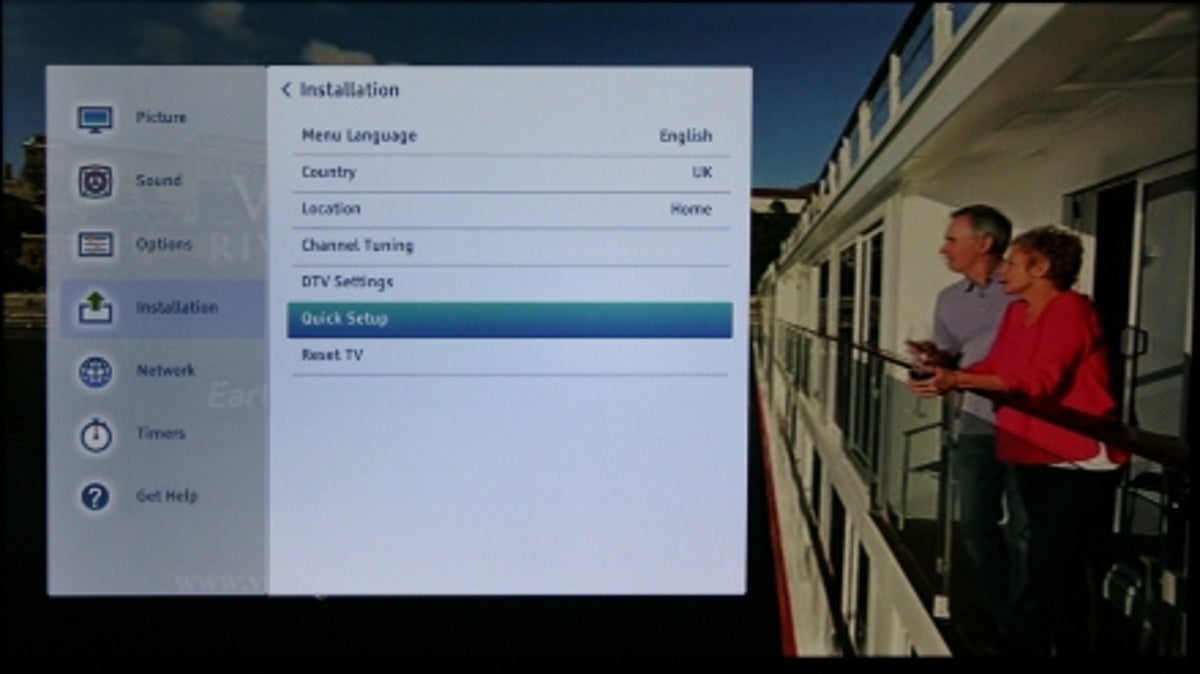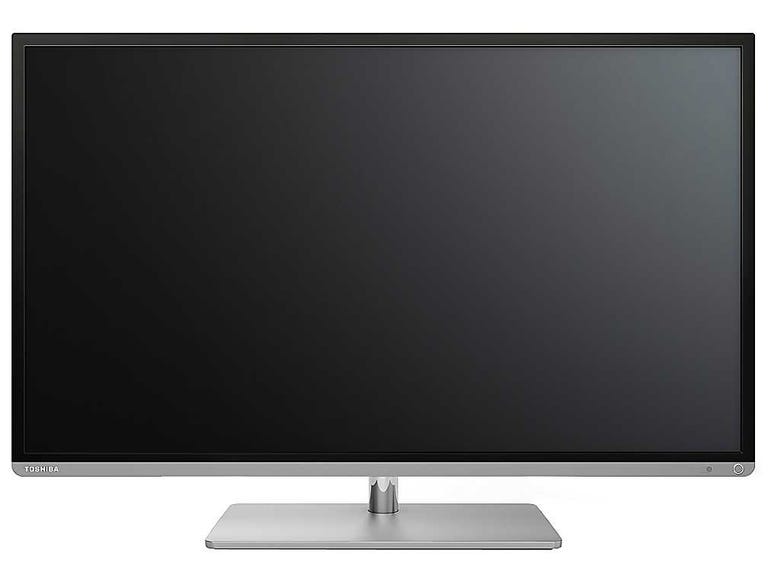 Why You Can Trust CNET
Why You Can Trust CNET Toshiba 32L6353 review: Toshiba 32L6353
There's plenty to like about Toshiba's stylish 32L6353 with decent picture performance for under £350, but for £40 more, Sony's KDL-32W653 has far better picture quality and smart TV system.
The Good
The Bad
The Bottom Line
User interface and TV guide
As soon as you turn on the TV, you're greeted by Toshiba's fresh new user interface. It looks much more modern than the company's old system, with crisper graphics and more user-friendly menus. A start-up wizard guides you though the process of connecting the TV to the Internet and tuning all the channels.
The various picture and audio settings are found tucked away in the main menu. This has a more traditional structure than Toshiba's old, wheel-based system, so it's more straightforward to use. Despite the set's low price, it has a strong array of picture tweaking options, including a colour-management system and two-point white-balance control. It also has Toshiba's AMR100 motion processing and Resolution+ upscaling system onboard.

This is all great, but the problem is that the menu system is annoyingly unresponsive. Often you find yourself clicking on the remote repeatedly to just try to get it to react -- it really is that sluggish.
As with Sony's latest TVs, Toshiba has decided to equip its models with two programming guides. There's a standard Freeview one that draws its information over the air and a secondary Internet enabled guide that's accessed via the set's smart TV system. The latter shows more information, such as the details of actors and directors, but it's very slow to start up, so not really worth the hassle.
The standard Freeview guide is more useable and shows a lot of programming information on the screen in one go. Its basic design means it's not visually appealing and it annoyingly lacks a video window, but it does at least keep the audio running in the background so you can keep tabs on the show you were watching when you open it up.
Smart TV system
The TV also comes with Toshiba's new smart TV system, or 'Cloud TV' as Toshiba calls it. This is split into a number of different screens that you move between using a rotating tab at the top.
The default screen is called 'Home' and has a number of panels showing the time and date, a video window of the current show you're watching as well as a suggestions box beneath with upcoming shows the smart TV system thinks you might want to watch. There's also a box towards the centre of the screen that shows TV-related tweets that are currently trending on Twitter. Unfortunately this box can’t be turned off and it doesn’t sensor rude words in tweets, so you do sometimes see some ripe language in there. That's something that won't be welcomed by those with youngsters in the house.
The other screens basically have different grids of smart TV apps and features such as shortcuts to the full web browser and the folder that stores recordings you've made to USB drives.
Toshiba has increased the number of apps available on Cloud TV compared to the old Places smart TV system. It now includes Netflix, for example, alongside BBC iPlayer and Blinkbox. It still falls a long way short of Samsung's system though, as there are no apps for popular services such as Lovefilm, 4oD and ITV Player.
The Cloud system seems to have been speeded up slightly since I last tried it out on the Toshiba 58L7365DB, but it still feels more sluggish to use than similar offerings from Panasonic, Samsung, Sony and LG.
As you'd expect, the set also has a digital media player onboard, although this is somewhat weirdly labelled as Contents in the Cloud TV system. It happily played Xvid and MKV files from USB drives and across a network from a NAS drive, but the fast-forward control works when streaming files and the rewind control doesn’t, which is both odd and annoying.
Design and connections
Despite its budget price, the 32L6353 has a stylish and contemporary design. I particularly like the metallic-effect flash across the bottom and the way it's curved at the edges to give it a feminine look. The bezel around the screen is narrow too, measuring just 18mm wide, and if you peer around the back you can see that the set is slim, with a depth of just 39mm at the top. It does extend out at the bottom to accommodate the down firing speakers, but its overall profile is still quite svelte.
The remote is long and wide, but at least this means the buttons are generously sized. The layout is on the whole well thought out with the buttons for key features such as the smart TV system grouped around the central D-pad. The buttons, however, aren't as responsive as I would have liked and feel quite spongy to the touch. When you add this to the sluggish feel of the user interface and smart TV system, well, it's just not a good mix.
The TV has excellent connectivity for a set in this price range though, as Toshiba has included four HDMI ports, one of which supports MHL so it can charge mobile devices when they're connected via a micro-USB to HDMI cable. It has both Ethernet and Wi-Fi built-in and the Wi-Fi chip supports WiDi so you can mirror the screens of compatible laptops to the TV. It doesn’t support Miracast though -- a similar technology for smart phones.
On the rear you'll find a full-sized Scart socket as well as component inputs and an optical digital output. The set has a VGA socket too, something that's a rarity on most of today's TVs, and there are two USB ports.
Audio quality
The 32L6353's audio quality is distinctly average. It's got enough volume to fill a decent sized room thanks to its two 10W speakers, but unlike many of today's sets there's no mini-woofer integrated into the rear to help out on the bass front. As a result, its audio sounds boxy and wooden as the speakers haven’t got enough low-end grunt to produce convincingly deep bass tones.
Picture quality
Given the price, I wasn't exactly expecting great things from the 32L6353 in terms of picture quality, especially as Toshiba's pricier L7365 was a pretty average performer in this department. The good news though, is that despite a few niggles, this model manages to produce a pretty punchy performance when you take into account its low price tag.
Toshiba's picture presets aren't half bad, especially the three Hollywood modes that are designed for day and nighttime movie viewing, so you don’t have to make lots of picture adjustments to get good results from it.
Colours are on the whole quite perky with natural hues, although skin tones can sometimes look a little on the yellow side, something that's not easy to get rid of using the picture controls. Sharpness levels are good though, and even standard definition sources, such as channels from the Freeview tuner, tend to look reasonably crisp. This is no doubt helped by the relatively small screen size on this model. I found it was best to leave Toshiba's Resolution+ upscaling system turned off, as all it seems to do is add in unnecessary sharpening to the picture, which increases image noise.
The main problem with the set is that its black levels aren't all that deep and its backlight is uneven so you can see some misting in the corners of the display during darker scenes, something you can’t get rid of without robbing the screen of its brightness.
On the whole, though, the 32L6353 performs better than expected in the picture department for a TV that comes in at under £350.
Conclusion
Toshiba's 32L6353 is nicely priced, produces pretty perky pictures and has a stylish design. Its smart TV system and overall user interface, however, is sluggish.
Sony's KDL-32W653 only costs around £40 more, but when we tested the 42-inch version of that set we found it had significantly better picture quality and a smart TV system with a better selection of apps. We've no reason to believe the 32-inch version performs any differently to its larger brother so ultimately, if you can afford the extra outlay we'd go for the 32-inch version of model instead.


